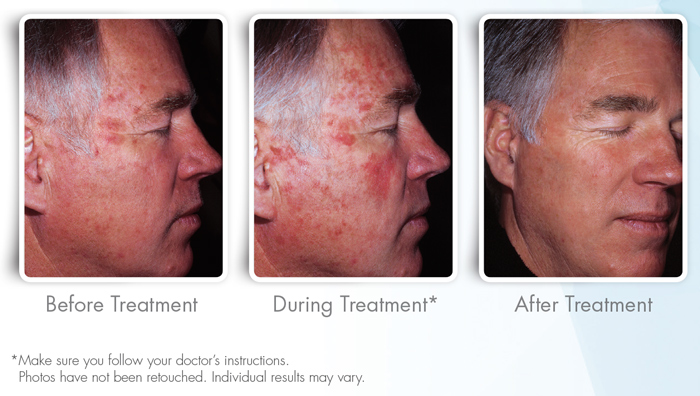Actinic Keratoses are pre-cancerous spots that appear on the skin as a result of prolonged exposure to the sun’s ultra-violet rays. They typically appear on areas of the body that receive the most consistent sun exposure over time, such as the face, scalp, and ears. Sometimes, these rough, scaly patches clear up on their own. But those that remain, if left untreated, are at risk of turning into squamous cell carcinoma, which is the second most common form of skin cancer.
Cryotherapy (Freezing)
This is our standard treatment for patients who have just one or even a few actinic keratoses. We freeze the spots off by applying liquid nitrogen. After treatment, the affected skin will blister and peel off, and will eventually be replaced with healthy new skin. The procedure takes only a few minutes here in our office.
How We Treat More Severe Cases of Actinic Keratosis
For patients with multiple spots, we treat the larger, affected area as a whole. This is a more complex treatment process.
Treatment Options
- 5-fluorouracil (5-FU) cream: This cream is applied to the skin twice a day for up to a month (or longer for more severe cases). Skin becomes red, raw, and irritated. Eventually the damaged skin crusts off, and healthy new skin appears.
- Diclofenac sodium gel: A non-greasy gel is applied to the skin twice day, for 2-3 months. During the treatment period, patients must avoid any sun exposure. Results typically begin to appear after a month. Any remaining spots can be treated with cryotherapy.
- Imiquimod cream: We create customized treatment plans for patients using this cream, and the treatment cycle typically lasts for about three weeks. The cream works by creating an immunologic response to destroy the damaged skin tissue. The affected area turns red and swells while using the cream. Once treatment ends, the skin will begin to heal.
- Ingenol mebutate gel: This gel is applied for either 2 or 3 days, depending on the location of the actinic keratoses. This treatment works exactly like imiquimod cream. The body’s immunologic response kicks in and the skin becomes red and swollen before it eventually heals.
This is a two-part procedure, completed in one office visit, that we use to target and destroy multiple spots of actinic keratoses. It is a highly effective treatment, but some insurance will only cover it for the face and scalp.
How It Works
A topical solution that mimics the effects of aminolevulinic acid (ALA), a naturally occurring substance in the body, is applied to the affected area. That solution is then absorbed by the damaged cells, and the result is a chemical that is very sensitive to light. Next, we expose those cells to a targeted light therapy that effectively destroys them, leaving the way for healthy new cells to take their place.
The side effects after PDT are similar to the side effects of treatment with prescription creams – redness and swelling before the affected area starts to heal.
What differs is the length of these side effects. With PDT, the redness and swelling generally subside after less than a week.










